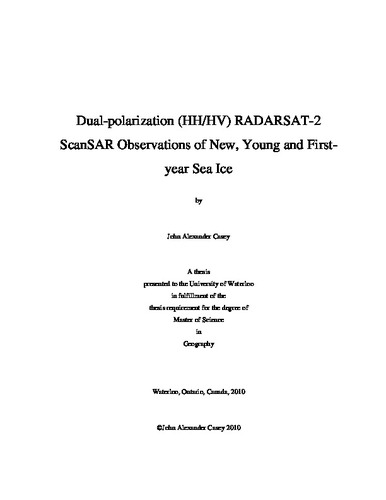| dc.description.abstract | Observations of sea ice from space are routinely used to monitor sea ice extent, concentration and type to support human marine activity and climate change studies. In this study, eight dual-polarization (dual-pol) (HH/HV) RADARSAT-2 ScanSAR images acquired over the Gulf of St. Lawrence during the winter of 2009 are analysed to determine what new or improved sea ice information is provided by dual-pol C-band synthetic aperture radar (SAR) data at wide swath widths, relative to single co-pol data. The objective of this study is to assess how dual-pol RADARSAT-2 ScanSAR data might improve operational ice charts and derived sea ice climate data records. In order to evaluate the dual-pol data, ice thickness and surface roughness measurements and optical remote sensing data were compared to backscatter signatures observed in the SAR data. The study found that: i) dual-pol data provide improved separation of ice and open water, particularly at steep incidence angles and high wind speeds; ii) the contrast between new, young and first-year (FY) ice types is reduced in the cross-pol channel; and iii) large areas of heavily deformed ice can reliably be separated from level ice in the dual-pol data, but areas of light and moderately ridged ice cannot be resolved and the thickness of heavily deformed ice cannot be determined. These results are limited to observations of new, young and FY ice types in winter conditions. From an operational perspective, the improved separation of ice and open water will increase the accuracy of ice edge and total ice concentration estimates while reducing the time required to produce image analysis charts. Further work is needed to determine if areas of heavily ridged ice can be separated from areas of heavily rafted ice based on knowledge of ice conditions in the days preceding the formation of high backscatter deformed ice. If rafted and ridged ice can be separated, tactical ridged ice information should be included on image analysis charts. The dual-pol data can also provide small improvements to ice extent and concentration data in derived climate data records. Further analysis of dual-pol RADARSAT-2 ScanSAR data over additional ice regimes and seasons is required. | en |

